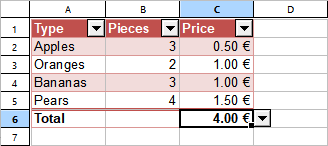As described in the introduction of the section Tables in worksheets, the ribbon command Insert | Table allows you to create "Tables in Worksheets". Below you will learn how to make use of the "Total row" in tables.
Tables are able to display a so-called Total row below its content. It displays calculations summing up the values contained in the table columns. The total row can be enabled/disabled anytime.

By default, the total row displays the text "Total" and the sum of the values in the right-most column. However, you can always edit the total row in order to perform different/additional calculations, as described below.
Enabling/disabling the total row
Tip: The total row can also be enabled directly on the ribbon tab Table | group Style.
To enable the total row for a table via the dialog box, proceed as follows:
| 1. | Move the cell frame to any cell within the table. |
| 2. | Choose the command Properties |
| Alternatively: Right-click on the table to open the context menu and select the entry Table settings |
| 3. | Activate the option Total row on the Style tab and confirm with OK. |
The total row is now displayed below the table.
If you do not want the total row to be displayed, disable this option again.
Customizing total rows
By default, the total row displays the text "Total" and the sum of the values in the right-most column.
However, you can adjust this at will. The cells in the total row can be edited – just like any other cell – so you can enter your own formulas or text here at any time.
A little helper is available for adding calculations that total the values in a column: When you move the cell frame to any cell in the total row, a little arrow ![]() appears to its right. Clicking on this arrow opens a menu offering different types of statistical functions (sum, average, etc.). When you pick e.g. the "Sum" entry, PlanMaker inserts a formula that calculates the sum of the corresponding column. For information on the formula used, see SUBTOTAL.
appears to its right. Clicking on this arrow opens a menu offering different types of statistical functions (sum, average, etc.). When you pick e.g. the "Sum" entry, PlanMaker inserts a formula that calculates the sum of the corresponding column. For information on the formula used, see SUBTOTAL.